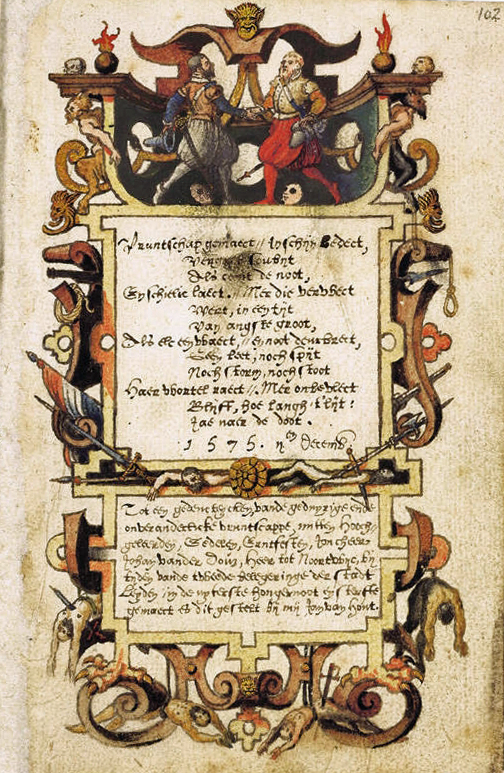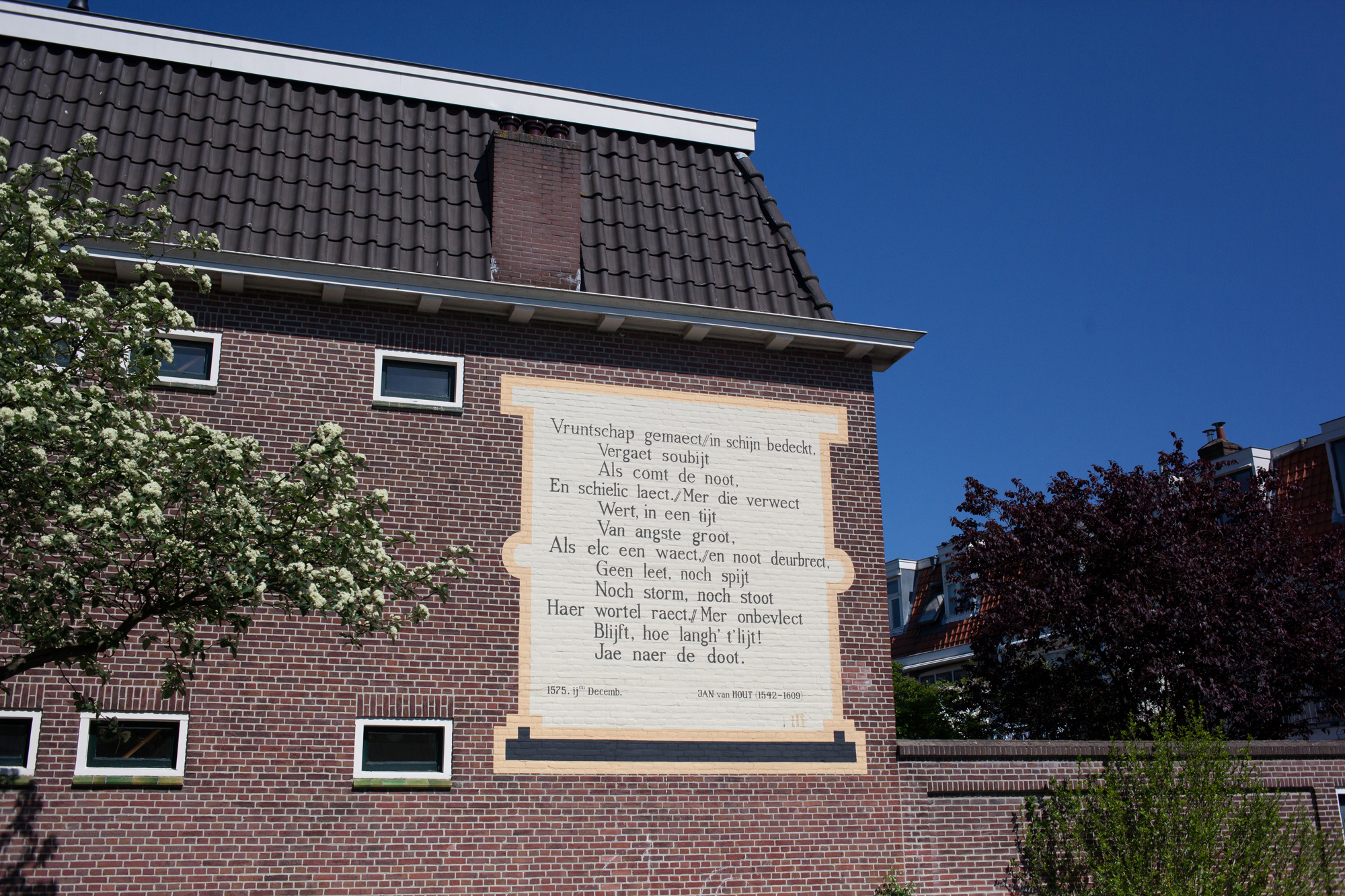Een vriendschap die geveinsd is en slechts schijn,
gaat ten onder,
zodra ze onder druk komt te staan,
en vervliegt snel. Maar op een vriendschap die wordt gesmeed
in een tijd van grote angst, wanneer iedereen
op zijn hoede is en de nood het hoofd biedt,
hebben droefheid noch spijt,
storm noch aanvallen vat. Zij blijft onbezoedeld
hoe lang ze ook duurt,
ja, ze overleeft zelfs de dood.
Vertaling: A.Th. Bouwman en C.L. Heesakkers
Listen to this poem in Early Modern Dutch.
Voiced by: Leo van Zanen
This poem in 60 seconds
Fake friendships fall apart when the going gets tough. It is only when times get difficult that real friendships spring to life. Jan van Hout spoke from personal experience when he captured this life lesson in this poem: he wrote it for his best friend.
Want to know more? On this website you can listen to the poem, discover its origins and its author and find out what the poem means to the people of Leiden.
Jan van Hout
Leiden 1542 - 1609
Jan van Hout was twenty years old when he became the assistant of Jacob van Milde, city clerk of Leiden. Two years later, in 1564, he succeeded Van Milde. It formed the basis of a governmental career that rose to a great height after the Siege of Leiden.
Siege of Leiden
In June 1572, Leiden sided with William of Orange, who fought against the lord of the Netherlands, Spanish king Philip II. In 1573 and 1574, the city was besieged and starved by the king’s troops, but without success. Jan van Hout played an important role during the siege and was one of the founders of Leiden University. He became secretary of the university council and was put in charge of the city printing office.
Poet
Van Hout advocated the use of the Dutch language at the university. He also often wrote poems in Dutch himself. This was not self-evident: in the 16th century, this language did not enjoy the same prestige as Latin or French. During his life, Van Hout had the status of innovator, because of his use of a relatively new meter, the iamb. In his poems, Van Hout follows every unstressed syllable with a stressed syllable. This ensured a melodious sound.
What's this poem about?
Jan van Hout’s poem is about friendship. In his poem, Van Hout describes two kinds of friendship. The first four lines consider friendship that is false and only needs a little nudge to break apart in hard times. To the second kind, good friendship, Van Hout dedicates the biggest part of his poem.
Good friendship
According to Van Hout, truly good friendships are made in hard times. Once this has happened, there is nothing that can affect such a friendship. In this poem, he claims that, even after death, friendship remains.
Personal
The friendship between Jan van Hout and Jan van der Does struck up during the Siege of Leiden. One year later, Van Hout wrote this poem in Van der Does’s album amicorum and also confirmed the unconditional friendship in prose underneath the poem. It goes without saying that this is a very personal poem.
Origin story

During the Siege of Leiden (1573 – 1574), Jan van Hout and Jan van der Does became close friends. They found a kindred spirit in each other at crisis meetings that took place from time to time. Both were steadfast and wanted nothing to do with negotiations with the Spanish enemy. After the siege, Van Hout was happy to contribute to Jan van der Does’s album amicorum. From his college years in Douai and Paris (1563 – 1566) onwards, Van der Does asked his friends to fill a page. Page 102 was reserved for Van Hout, who wrote a poem about friendship especially for this occasion.
Decorated frame
Jan van Hout was probably not the only one who worked on his contribution, because the poem in the album amicorum is beautifully decorated. Although Van Hout was not bad at sketching, this appears to be the work of a professional. The decorated frame depicts two men shaking hands, a sign of friendship par excellence. Above them rests a friendly satyr head - a mythical creature that is believed to keep away evil spirits. The frame also shows two heads that represent life and death. Underneath, the decorations contain references to the Siege of Leiden: gallows, canon barrels, ropes, swords, a Beggars’ flag and victims of battle or hunger.
Share your story
Does this poem hold a special place in your heart? For example, do you remember when you first read the poem? Or did you come across it someplace unexpected? Let us know at muurgedichten@taalmuseum.nl! We would love to add your story to our website.
Jan van Hout in Leiden

Photo: Anoesjka Minnaard
Jan van Hout is inextricably linked to the Siege of Leiden. After the siege, he was one of the organizers of the commemoration, from which the 3 October Festival arose. He also wrote Der stadt Leyden dienst-bouck (‘service book of the city Leiden’, 1602), hymns about the relief of Leiden.
Wall poem
This wall poem can be found at Buitenruststraat 1 in Leiden since 1993. It was the 33rd wall poem that was realized by the TEGEN-BEELD Foundation.
Jan van Hout and Leiden
Jan van Hout is inextricably linked to Leiden. This is because of his position as city clerk and the role he played during the Relief of Leiden. This is also the first thing that people from Leiden will tell you when you ask them about Jan van Hout. In Leiden you will encounter other places besides this wall poem in memory of him, such as street names and the monument at the Plantsoen park.
Multifaceted
After the siege, Van Hout also played an important role in many issues revolving around urban life in Leiden. For example, he was the secretary of curators of the university that, after the relief, was the first university of the Netherlands. Besides this, he also busied himself with reorganizing poor relief and he wanted to establish a useful way of punishing criminals, just like in Amsterdam. He also supervised the city printing office and essentially was the city archivist.
Quotes
“Maybe it would have better pleased poetry experts if I had written my poem in French [...] our language was first used by the great poet Jan van Hout.”
Karel van Mander (1548 - 1606) in the Preface of Den Grondt der Edel vry Schilder-const (‘The basics of the noble art of painting’)
Fun facts
- At the end of his life, Jan van Hout was not happy with his writing. In his will, he called everything he had dreamed or twaddled (made up or fantasized) a waste of time. Het left his literary work to his friend Petrus Bertius, who could do anything he wanted with it, except publish it. He honored his friend’s wish and never published it, which is why a lot has been lost.
- The poem by Jan van Hout in Jan van der Does’s album amicorum was one of 135 works in the album. It contains many other beautiful contributions that have been written in a period of 34 years. The album amicorum is displayed at the Leiden University Library. In 2009, a facsimile of the book was published.
- Conversely, Jan van der Does also wrote in Jan van Hout’s album amicorum. The book by Van Hout differs considerably from that of Van der Does. Only 26 friends wrote in it and no paintings, drawings or engravings have been made inside. It also circulated for a shorter time: all contributions are from 1578 and 1579.
- Jan van Hout can be found at several locations throughout Leiden. The Jan van Houtbrug (‘Jan van Hout Bridge’), built in 1923, and the Jan van Houtkade (‘Jan van Hout Wharf’) have been named after him; his likeness is also placed there, at the monument in memory of 350 years after the Relief of Leiden. The gold-plated text over the left gate of city hall is also his. This work contains 131 letters: exactly as many days as the Siege of Leiden lasted.
- In the years after the siege, Van Hout was inspired by Platonic ideas of which divine perfection and harmony were important aspects. According to this theory, everything on earth was a rough outline of the ideal cosmic reality, mankind could try to come in harmony with this.
Vruntschap gemaect // in schijn bedeckt,
Vergaet soubijt
Als comt de noot,
En schielic laect.// Mer die verwect
Wert, in een tijt
Van angste groot,
Als elc een waect,// en noot deurbrect,
Geen leet, noch spijt
Noch storm, noch stoot
Haer wortel raect//. Mer onbevlect
Blijft, hoe langh’t’lijt!
Jae naer de doot.
Friendship made // veiled in pretence
Dissolves at once
When disaster strikes,
And passes quickly.// But if begot
In times of
Fears so great,
When each a guard,// and need arises,
No grief, nor rue
Nor storm, nor blow
Her roots affects//. But unblemished
It remains, as time goes on!
Yes, after death.
Translation: Jasmijn van Dongen
Learn more
This entry was written by Het Taalmuseum in collaboration with Sophie van Aardenne. The translation into English is by Jasmijn van Dongen. The following sources were consulted:
- DBNL.org about Jan van Hout
- Dutch Revolt in Leiden
- Ecyclopaedia Brittanica
- Bostoen, Karel, Hart voor Leiden. Jan van Hout (1542-1609), stadssecretaris, dichter en vernieuwer (Hilversum 2009).
- A.Th. Bouwman en C.L. Heesakkers, Een netwerk aan de basis der Leidse universiteit. Tentoonstelling bij de uitgave van het album amicorum van Janus Dousa, Universiteitsbibliotheek Leiden, 5 - 30 June 2000.
